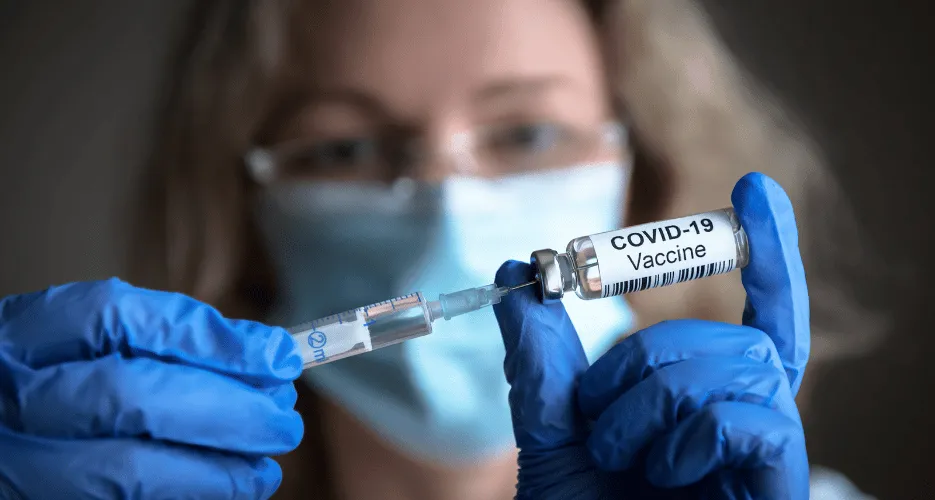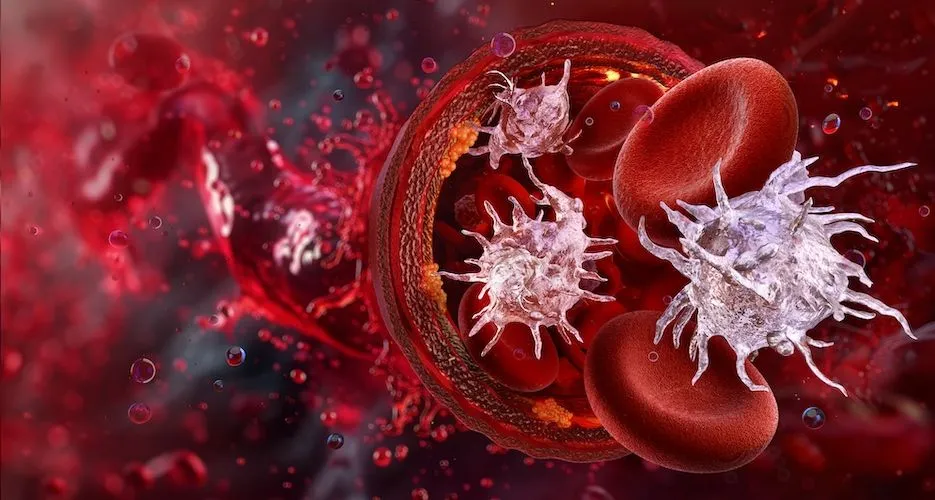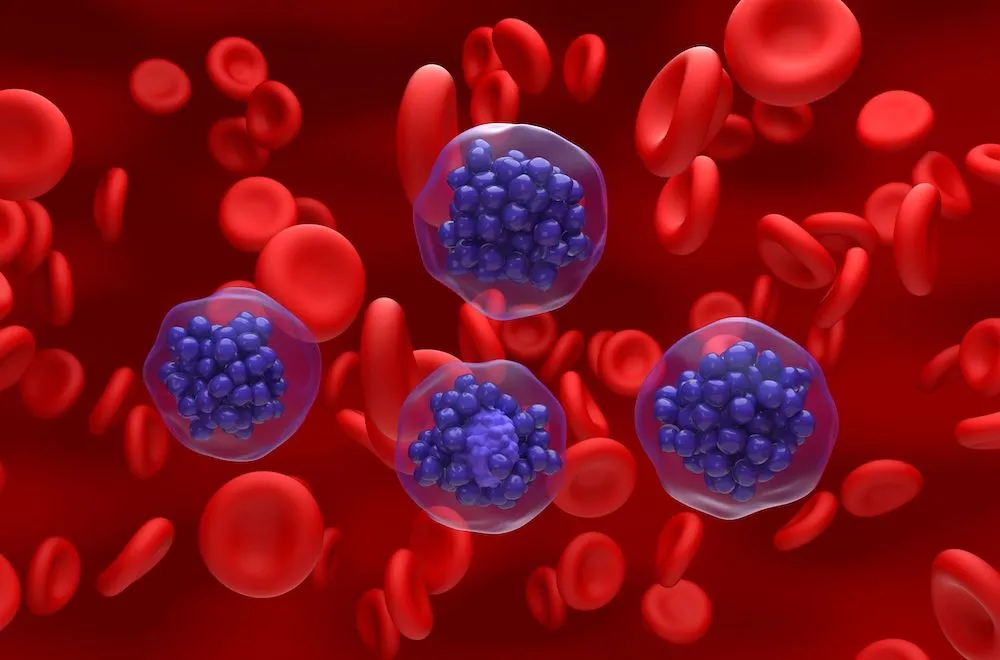How Do Oxidative Stress and Antioxidants Impact Immune System Cells?

What is oxidative stress, and how does it impact cancer-killing immune system cells? Learn answers to these questions and more below!
How Do Immune System Cells Lose Their Power to Fight Cancer?
In healthy individuals, certain immune system cells like T cells and natural killer (NK) cells have the capability to kill cancer cells. In people with cancer, these cells often stop being effective at killing cancer as they show signs of exhaustion.
Dr. Santosha Vardhana from Memorial Sloan Kettering Cancer Center (MSK) found that immune system cell exhaustion is caused by oxidative stress and is reversible with antioxidants. When oxidative stress is high, it negatively impacts cells’ mitochondria, limiting their ability to produce energy and keep immune system cells working properly.
When antioxidants were administered, they reversed the mitochondrial damage, keeping the immune system cells working well to continue killing cancer cells.
What is Oxidative Stress?
Oxidative stress refers to an imbalance of too many free radicals (unpaired electrons) and not enough antioxidants to neutralize them. If free radicals are not neutralized with antioxidants, they remain chaotically unpaired, damaging parts of the body. Over time, oxidative stress is the underlying condition that contributes to chronic inflammation, insulin resistance, diabetes, and cardiovascular disease.
Free radicals are a normal byproduct of certain body processes. However, they can be produced in excess under certain conditions (please see the next section for these instances).
Your body naturally produces antioxidants like glutathione in the liver and has the capability to balance free radicals to a certain extent. The issue arises when there becomes an imbalance of too many sources causing high amounts of free radicals and not enough antioxidants to neutralize them. To balance this, additional antioxidants are needed, such as through nutrition, and measures need to be taken to reduce external sources of oxidative stress.
What are the Sources of Oxidative Stress?
There are various sources that can cause a buildup of free radicals and not enough antioxidants to neutralize them (referred to as oxidative stress). Some of them include:
- Sleep deprivation
- Excess psychological stress
- Excess intense exercise
- "Antioxidant defenses are sufficient to meet an increase in free radical production during low-intensity exercise, but as exercise-intensity increases, these defenses are surpassed, resulting in significant oxidative stress" -Aspetar Sports Medicine Journal
- Certain viruses like COVID-19
- Over time, the oxidative stress buildup leads to high inflammation and chronic fatigue. Reducing oxidative stress with antioxidants can help reduce cellular fatigue
- Foods that, during the refining process, strip the food of their natural antioxidants, causing excess free radicals to be produced when they are metabolized
- Examples include refined carbohydrates and refined sugars. To reduce excess oxidative stress, swap with whole grain flour and cane sugar. These contain natural antioxidants that help balance your body’s redox state (the balance between antioxidants and free radicals)
- Artificial sweeteners like aspartame
- Meats cured with nitrates and nitrites
- Excess iron consumption
- Imbalance of too much copper and not enough zinc (click here to read how your home’s plumbing may affect this and strategies to manage)
- Cigarette smoke
- Alcohol
- Herbicides and pesticides
- Radiation
- Pollution
- Intake of harmful metals like lead, mercury, and aluminum
How Can I Reduce Oxidative Stress?
You may not have control over all sources of oxidative stress; however, listed below are foods and spices with the highest antioxidant capacity that are proven to reduce excess free radicals.
If your oxidative stress level (sometimes referred to as your redox balance) has been too high for a long period of time, it may have damaged your liver’s ability to make enough of its own antioxidant glutathione. Studies have shown that it takes about three months of consistent supplemental antioxidant therapy to keep free radical levels low enough that your body can repair and improve its ability to make antioxidants well again.
Measuring Antioxidant Levels in Food/Spices
The antioxidant level in food is measured using the Oxygen Radical Absorbance Capacity (ORAC) value.
“ORAC value uses the "total antioxidant capacity" of a food by placing a sample of the food in a test tube, along with certain molecules that generate free radical activity and certain other molecules that are vulnerable to oxidation. After a while, they measured how well the sample protected the vulnerable molecules from oxidation by the free radicals. The less free radical damage there is, the higher the antioxidant capacity of the test substance” (ORAC value).
Here is a list of foods and spices with high ORAC values (spice list is per 100g):
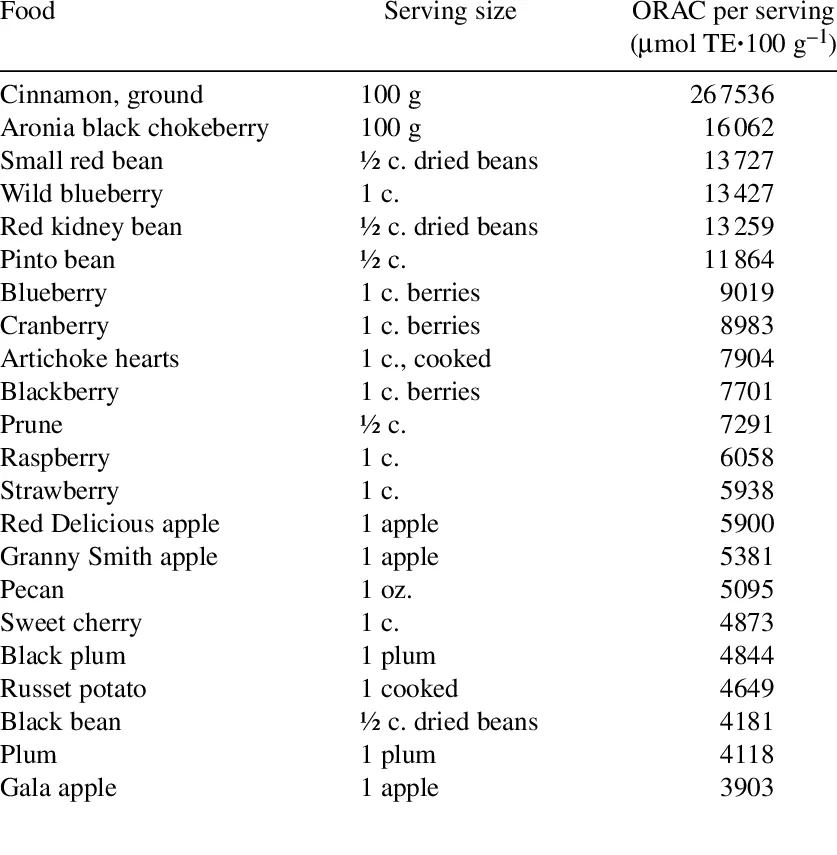
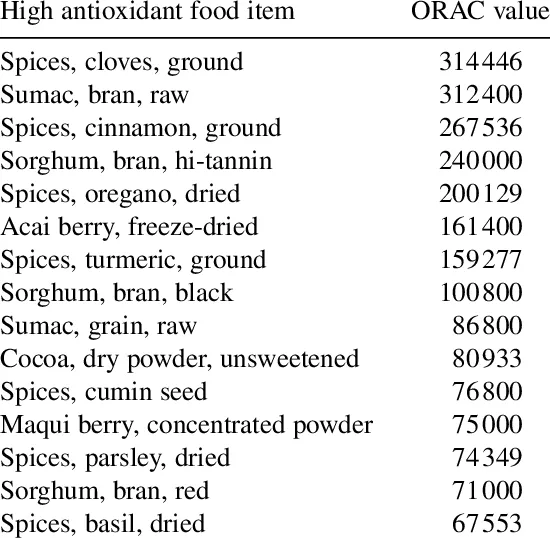
Some blood cancer patients from HealthTree have reported trying the highest antioxidant spice clove powder packed into capsules to improve their redox balance. You can either make the capsules yourself or purchase them from an online retailer such as here.
Patients have also suggested defrosting a few cups of wild blueberries (found in the freezer section next to regular blueberries) and immersion blending with a little water for a high-antioxidant sweet drink.
Is it Safe for Cancer Patients to Use Antioxidant Therapy?
In slow-growing (chronic) cancers, reducing sources of inflammation like oxidative stress may be a safe way of improving treatment effectiveness. Click here to learn more. Antioxidants may support these patients and be safe to help cells undergo apoptosis, a process in which cells self-recognize that they are damaged and self-destruct if they are unable to repair themselves.
In fast-growing (acute) cancers, it may be safest to wait to introduce high-antioxidant foods/spices to your diet after your standard cancer treatment helps you achieve remission. This is because antioxidants de-exhaust all cells, including cancer cells. It may not be safe to de-exhaust your body’s microenvironment while waiting for your cancer-killing immune system cells to play catch-up, which may allow aggressive cancer cells to spread even faster.
Further research is needed to help identify the best timing for this. Additional strategies being tried include pairing antioxidant therapy with cellular therapies to help empower the re-engineered immune system cells and avoid exhaustion, as seen in a clinical trial at MSK for lymphoma patients. Similar trials using this strategy may support other patients receiving cellular therapies like CAR-T.
Protect Healthy Cells From Free Radical Damage
Reducing excess oxidative stress by increasing antioxidant consumption helps protect healthy cells and their DNA. High amounts of free radicals for long periods of time may damage cells' DNA. If the free radicals happen to damage part of the DNA that contains instructions to repair DNA, suppress tumors, or tell cells beyond repair to die, then the cell is left with damaged instructions that could then allow the ineffective mutated cell to keep multiplying (cancer cell).
Summary
Reducing free radical buildup with supplemental antioxidants may help your immune system cells effectively kill cancer cells and avoid exhaustion. It is likely safest to try this at-home approach once in remission following standard cancer treatment. Additional research is needed to evaluate strategies to combine antioxidants with cellular therapies to support treatments like CAR-T for reducing T-cell exhaustion.
Sources:
- Free Radical | National Cancer Institute
- Study Shows How Immune Cells Lose Their Power to Fight Tumors
- Comparison of Antioxidant Properties of Refined and Whole Wheat Flour and Bread
- Aspartame and Its Metabolites Cause Oxidative Stress and Mitochondrial and Lipid Alterations in SH-SY5Y Cells
- Total antioxidant content of alternatives to refined sugar
- COVID-19 and Oxidative Stress
- Exercise and oxidative stress: An exercise paradox?
- Mechanisms of the bactericidal effects of nitrate and nitrite in cured meats
- Dietary Regulation of Oxidative Stress in Chronic Metabolic Diseases
- Metals, toxicity and oxidative stress
- Aluminum induced oxidative stress, astrogliosis and cell death in rat astrocytes, is prevented by curcumin
- Relationships among smoking, oxidative stress, inflammation, macromolecular damage, and cancer
- Alcohol-induced oxidative stress
- A Common Feature of Pesticides: Oxidative Stress—The Role of Oxidative Stress in Pesticide-Induced Toxicity
- Radiation and oxidative stress
- Oxidative Stress and Air Pollution Exposure
- Oxidative Stress and Psychological Disorders
- A Narrative Review of the Reciprocal Relationship Between Sleep Deprivation and Chronic Pain: The Role of Oxidative Stress
- Mitochondrial oxidative phosphorylation is linked to T-cell exhaustion
- Anti-oxidant capacity and anti-tumor T cell function: A direct correlation
- Efficacy of glutathione for the treatment of nonalcoholic fatty liver disease: an open-label, single-arm, multicenter, pilot study
- Antioxidant and anti-inflammatory agents in chronic liver diseases: Molecular mechanisms and therapy
- The role of tumor suppressor p53 in the antioxidant defense and metabolism
- Foods and Spices ORAC
- What Are ORAC Values?
What is oxidative stress, and how does it impact cancer-killing immune system cells? Learn answers to these questions and more below!
How Do Immune System Cells Lose Their Power to Fight Cancer?
In healthy individuals, certain immune system cells like T cells and natural killer (NK) cells have the capability to kill cancer cells. In people with cancer, these cells often stop being effective at killing cancer as they show signs of exhaustion.
Dr. Santosha Vardhana from Memorial Sloan Kettering Cancer Center (MSK) found that immune system cell exhaustion is caused by oxidative stress and is reversible with antioxidants. When oxidative stress is high, it negatively impacts cells’ mitochondria, limiting their ability to produce energy and keep immune system cells working properly.
When antioxidants were administered, they reversed the mitochondrial damage, keeping the immune system cells working well to continue killing cancer cells.
What is Oxidative Stress?
Oxidative stress refers to an imbalance of too many free radicals (unpaired electrons) and not enough antioxidants to neutralize them. If free radicals are not neutralized with antioxidants, they remain chaotically unpaired, damaging parts of the body. Over time, oxidative stress is the underlying condition that contributes to chronic inflammation, insulin resistance, diabetes, and cardiovascular disease.
Free radicals are a normal byproduct of certain body processes. However, they can be produced in excess under certain conditions (please see the next section for these instances).
Your body naturally produces antioxidants like glutathione in the liver and has the capability to balance free radicals to a certain extent. The issue arises when there becomes an imbalance of too many sources causing high amounts of free radicals and not enough antioxidants to neutralize them. To balance this, additional antioxidants are needed, such as through nutrition, and measures need to be taken to reduce external sources of oxidative stress.
What are the Sources of Oxidative Stress?
There are various sources that can cause a buildup of free radicals and not enough antioxidants to neutralize them (referred to as oxidative stress). Some of them include:
- Sleep deprivation
- Excess psychological stress
- Excess intense exercise
- "Antioxidant defenses are sufficient to meet an increase in free radical production during low-intensity exercise, but as exercise-intensity increases, these defenses are surpassed, resulting in significant oxidative stress" -Aspetar Sports Medicine Journal
- Certain viruses like COVID-19
- Over time, the oxidative stress buildup leads to high inflammation and chronic fatigue. Reducing oxidative stress with antioxidants can help reduce cellular fatigue
- Foods that, during the refining process, strip the food of their natural antioxidants, causing excess free radicals to be produced when they are metabolized
- Examples include refined carbohydrates and refined sugars. To reduce excess oxidative stress, swap with whole grain flour and cane sugar. These contain natural antioxidants that help balance your body’s redox state (the balance between antioxidants and free radicals)
- Artificial sweeteners like aspartame
- Meats cured with nitrates and nitrites
- Excess iron consumption
- Imbalance of too much copper and not enough zinc (click here to read how your home’s plumbing may affect this and strategies to manage)
- Cigarette smoke
- Alcohol
- Herbicides and pesticides
- Radiation
- Pollution
- Intake of harmful metals like lead, mercury, and aluminum
How Can I Reduce Oxidative Stress?
You may not have control over all sources of oxidative stress; however, listed below are foods and spices with the highest antioxidant capacity that are proven to reduce excess free radicals.
If your oxidative stress level (sometimes referred to as your redox balance) has been too high for a long period of time, it may have damaged your liver’s ability to make enough of its own antioxidant glutathione. Studies have shown that it takes about three months of consistent supplemental antioxidant therapy to keep free radical levels low enough that your body can repair and improve its ability to make antioxidants well again.
Measuring Antioxidant Levels in Food/Spices
The antioxidant level in food is measured using the Oxygen Radical Absorbance Capacity (ORAC) value.
“ORAC value uses the "total antioxidant capacity" of a food by placing a sample of the food in a test tube, along with certain molecules that generate free radical activity and certain other molecules that are vulnerable to oxidation. After a while, they measured how well the sample protected the vulnerable molecules from oxidation by the free radicals. The less free radical damage there is, the higher the antioxidant capacity of the test substance” (ORAC value).
Here is a list of foods and spices with high ORAC values (spice list is per 100g):


Some blood cancer patients from HealthTree have reported trying the highest antioxidant spice clove powder packed into capsules to improve their redox balance. You can either make the capsules yourself or purchase them from an online retailer such as here.
Patients have also suggested defrosting a few cups of wild blueberries (found in the freezer section next to regular blueberries) and immersion blending with a little water for a high-antioxidant sweet drink.
Is it Safe for Cancer Patients to Use Antioxidant Therapy?
In slow-growing (chronic) cancers, reducing sources of inflammation like oxidative stress may be a safe way of improving treatment effectiveness. Click here to learn more. Antioxidants may support these patients and be safe to help cells undergo apoptosis, a process in which cells self-recognize that they are damaged and self-destruct if they are unable to repair themselves.
In fast-growing (acute) cancers, it may be safest to wait to introduce high-antioxidant foods/spices to your diet after your standard cancer treatment helps you achieve remission. This is because antioxidants de-exhaust all cells, including cancer cells. It may not be safe to de-exhaust your body’s microenvironment while waiting for your cancer-killing immune system cells to play catch-up, which may allow aggressive cancer cells to spread even faster.
Further research is needed to help identify the best timing for this. Additional strategies being tried include pairing antioxidant therapy with cellular therapies to help empower the re-engineered immune system cells and avoid exhaustion, as seen in a clinical trial at MSK for lymphoma patients. Similar trials using this strategy may support other patients receiving cellular therapies like CAR-T.
Protect Healthy Cells From Free Radical Damage
Reducing excess oxidative stress by increasing antioxidant consumption helps protect healthy cells and their DNA. High amounts of free radicals for long periods of time may damage cells' DNA. If the free radicals happen to damage part of the DNA that contains instructions to repair DNA, suppress tumors, or tell cells beyond repair to die, then the cell is left with damaged instructions that could then allow the ineffective mutated cell to keep multiplying (cancer cell).
Summary
Reducing free radical buildup with supplemental antioxidants may help your immune system cells effectively kill cancer cells and avoid exhaustion. It is likely safest to try this at-home approach once in remission following standard cancer treatment. Additional research is needed to evaluate strategies to combine antioxidants with cellular therapies to support treatments like CAR-T for reducing T-cell exhaustion.
Sources:
- Free Radical | National Cancer Institute
- Study Shows How Immune Cells Lose Their Power to Fight Tumors
- Comparison of Antioxidant Properties of Refined and Whole Wheat Flour and Bread
- Aspartame and Its Metabolites Cause Oxidative Stress and Mitochondrial and Lipid Alterations in SH-SY5Y Cells
- Total antioxidant content of alternatives to refined sugar
- COVID-19 and Oxidative Stress
- Exercise and oxidative stress: An exercise paradox?
- Mechanisms of the bactericidal effects of nitrate and nitrite in cured meats
- Dietary Regulation of Oxidative Stress in Chronic Metabolic Diseases
- Metals, toxicity and oxidative stress
- Aluminum induced oxidative stress, astrogliosis and cell death in rat astrocytes, is prevented by curcumin
- Relationships among smoking, oxidative stress, inflammation, macromolecular damage, and cancer
- Alcohol-induced oxidative stress
- A Common Feature of Pesticides: Oxidative Stress—The Role of Oxidative Stress in Pesticide-Induced Toxicity
- Radiation and oxidative stress
- Oxidative Stress and Air Pollution Exposure
- Oxidative Stress and Psychological Disorders
- A Narrative Review of the Reciprocal Relationship Between Sleep Deprivation and Chronic Pain: The Role of Oxidative Stress
- Mitochondrial oxidative phosphorylation is linked to T-cell exhaustion
- Anti-oxidant capacity and anti-tumor T cell function: A direct correlation
- Efficacy of glutathione for the treatment of nonalcoholic fatty liver disease: an open-label, single-arm, multicenter, pilot study
- Antioxidant and anti-inflammatory agents in chronic liver diseases: Molecular mechanisms and therapy
- The role of tumor suppressor p53 in the antioxidant defense and metabolism
- Foods and Spices ORAC
- What Are ORAC Values?

about the author
Megan Heaps
Megan joined HealthTree in 2022. She enjoys helping patients and their care partners understand the various aspects of the cancer. This understanding enables them to better advocate for themselves and improve their treatment outcomes.
More on Navigating Your Health
Trending Articles
Get the latest thought leadership on your Blood Cancer delivered straight to your inbox
Subscribe to the weekly newsletter for news, stories, clinical trial updates, and helpful resources and events with cancer experts.
Thanks to our HealthTree Community for Blood Cancer Sponsors:
.svg_64899492-87cd-4df9-9d4b-07f9618df890.png?alt=media)


